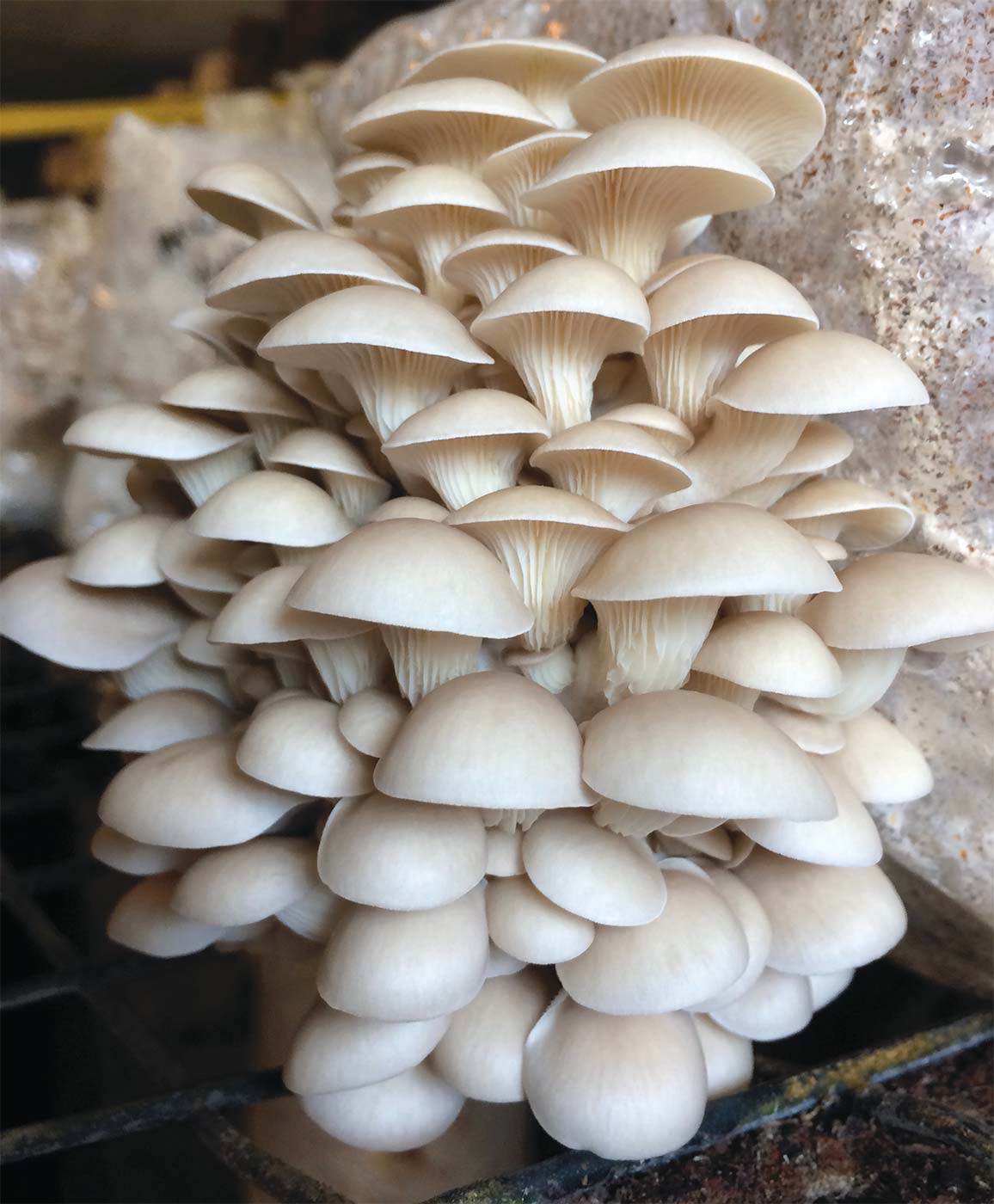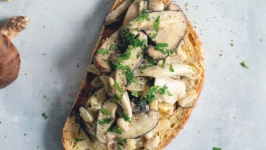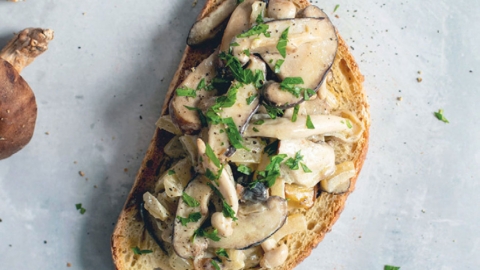Growing Gourmet Edible Mushrooms
Many people think that gourmet edible mushrooms grow only in far-away forests, where leaves, moisture, and shade provide the ideal habitat. And while that’s true for some exotic varieties, there are many types of mushroom that you can grow, right in your backyard or in your home. Getting started is easy and fun.
In the Northeast, there are five mushrooms that are especially easy to cultivate at home. We present them here, with one way to grow each. We hope they whet your appetite to learn more about the fascinating world of growing mushrooms. While there are many vendors of mushroom-growing supplies, we’ve had good results with products from Field and Forest Products (see sidebar). Ask your local nursery and growing center—or mushroom vendor—for other recommendations.
First, some basics. Mushrooms have been evolving on earth for 700–800 million years. Yes, millions of years! They are the fruiting bodies of the fungus that pop up and are visible for harvesting to eat, and their caps come in many shapes, sizes, colors, textures, and flavors. All mushrooms come from mycelium (a network of root-like threads) but not all mycelium will produce mushrooms. Much like vegetables propagate via seeds, mushrooms reproduce using spores. Spores need ample water and nutrients to thrive, and can quickly produce their own mycelium network, which then produces mushrooms, the “fruit.”
For mushrooms that grow outdoors—with or without human cultivation—the weather makes all the difference. Fall’s cooler temperatures make it the perfect time to start growing your own. And today, there are many ways to grow mushrooms indoors as well during the fall when inside home temperatures are naturally cooler. Different mushroom varieties require different growing mediums for successful propagation. Examples are sawdust, wood chips, compost, and oak or sugar maple logs.
Here are five good choices to get you started with growing your own mushrooms at home:
■ The delicious Almond Agaricus mushroom is similar to the portobello, with a hint of almond flavor. These mushrooms sprout quickly and can grow in a flowerpot. [We recommend starting with the Garden Starter Kit from Field and Forest Products.] In a large pot, add organic compost from your yard or a bag from your local garden center. Then mix sawdust spawn (sawdust pre-mixed with spores) into the compost in the pot and add water. If you’re already composting food scraps, mixing the sawdust spawn into your compost pile is another option. Keep the mycelium moist by watering consistently and watch the mushrooms sprout. Quick and easy for beginners!
ALL MUSHROOMS COME FROM MYCELIUM (A NETWORK OF ROOT-LIKE THREADS) BUT NOT ALL MYCELIUM WILL PRODUCE MUSHROOMS.
■ The second variety is Wine Cap, which can be grown outside on straw beds or in a pile of hardwood chips. Integrate them into your perennial flower beds for added splendor. Wine caps usually fruit twice a year (spring and fall) and will take approximately six months for the first fruit to appear. In year one, start with sawdust spawn from Field and Forest Products or another supplier, adding the sawdust containing the spores to your straw or wood chips. The wine caps will fruit quickly in the first year. To continue cultivation in year two, use the peg spawn from Field and Forest. The thin wooden dowels are the substrate that contain the mycelium of the wine cap fungus. Push the pegs into the pile of wood chips, your mushroom “bed” growing area, and the wine caps keep growing year after year. Inside the pile, the mycelium keeps growing and fruiting if you keep the conditions moist.
■ Oyster mushrooms can be grown in a bucket of straw in your house or a tabletop container. King Oyster is my favorite oyster mushroom variety. The kit from Field and Forest will produce 1–1.75 pounds of King Oyster mushrooms per tabletop farm. Keep your indoor temperature below 65°F for best results. When the kit arrives, it will start to fruit as soon as it’s opened into room temperature. King Oysters are ready to harvest in two to three weeks.
■ Shiitake mushrooms are another of my favorites and can be grown on oak or sugar maple logs. When oak or sugar maple trees or tree limbs fall down in a storm, you can easily repurpose them as the growing medium for shiitake mushrooms. Drill holes in the logs and push the spawn into the holes, sealing the holes with beeswax. Wait a year for the first fruit to be harvested. After the first harvest, you will likely be able to harvest a couple times a year for five to 10 years, from a log that is six inches in diameter. Keep the logs in the shade and keep them moist. To harvest, cut the shiitake off the log with scissors or a sharp knife.
■ Lion’s Mane mushrooms are large, white, shaggy mushrooms that look like a lion’s mane when they are fully grown and ready to eat. Slice them, stir-fry, and you will think you’re eating crab or lobster due to the taste and texture. The easiest way to grow Lion’s Mane indoors is with a tabletop farm. Similar to oyster mushrooms, the temperature should be kept below 65° in your home for best results. When the tabletop farm arrives in the mail from Field and Forest, it will start to fruit as soon as it’s opened into room temperature. You will be able to harvest in 10–14 days. Lion’s Mane can also be grown outside on logs with a similar method used for shiitake. Beech is the best type of tree to use due to it being medium-hard to medium-soft hardwood, not the oak that works best for shiitake.
Two other varieties of mushrooms that can be grown at home are Reishi and Morel. Visit the Field and Forest web-site (see sidebar) or call them to find out how. Their staff has a wealth of information to share about the outdoor and indoor options of growing from spawn/spores and kits—and bringing the funtastic world of fungi to life in your home, yard, and plate.

FOREST TO PLATE
Growing and cooking mushrooms at home brings the fragrance and flavors of the forest right onto your plate. The essential role that fungi play in the web of life is mostly hidden to human eyes but can be understood bite by bite, as we experience the art of cultivating different mushroom varieties and eating them. Watching how quickly mushrooms sprout and grow can also be a way for children and adults of all ages to gain a deeper appreciation of nature’s capacity to astonish all our senses. The brilliance and beauty of these special earth organisms do more than just satisfy our taste buds and eyes. They play a critical role in enabling plant life to thrive on earth, especially trees. By growing mushrooms at home, you are helping the biodiversity in your yard to thrive. You are a producer, not just a consumer. You influence the habitat around you and steward life forward. You make a difference in the seen and unseen world of natural beauty in your yard. And since all is connected in the web of life, you make a difference in the future of life on earth, too.
A NOTE ON SOURCING
When you are a beginner growing mushrooms, it is important to work with experts. You also need to trust that the spawn is cultivated correctly, packaged and shipped properly, is alive when you get it, and will work when you use it. I have recommended Field and Forest (fieldforest.net) and many of their products throughout this article as I have found them to be a trusted source for many years. In business since 1983, their phone lines are staffed by knowledgeable experts who are full of insight and helpful suggestions, and are deeply committed to helping people grow mushrooms. www.fieldforest.net
Many companies offer mushroom products to help the home grower and mushroom enthusiast, both online and at quality retailers. Ask your local nursery and growing center—or mushroom vendor—for recommendations. – WK
BEYOND FLAVOR: HEALTH BENEFITS OF MUSHROOMS
In addition to the fascinating spectrum of flavor, mushrooms have many medicinal properties. Lion’s Mane is known for its ability to stimulate the growth of new brain cells and its support of the immune system, heart, and digestion, as well as reducing inflammation in the body. Shiitake contain the highest levels of vitamin B in any mushroom, along with vitamin D and lentinan. Shiitakes are also adaptogens; they reduce the body’s reaction to stress.
Mushrooms have many bioactive components like phenolics and terpenoids with known medical benefits. There are mushroom tinctures, powders, “mushroom coffee” drinks, and capsules that can also be explored. American mycologist Paul Stamets is considered the world’s leading researcher and source of information on the health benefits of mushrooms. Learn more at www.fungi.com.
GROWING OPTIONS FOR MUSHROOMS:
How spores (spawn) are provided
| PLUG | GRAIN | SAWDUST | PEG | |
| ALMOND AGARICUS | X | |||
| SHIITAKE | X | X | ||
| OYSTER | X | X | X | |
| LIONS’S MANE | X | X | X | |
| REISHI | X | X | X | |
| WINE CAP | X | X | ||
| MOREL | X | X |








